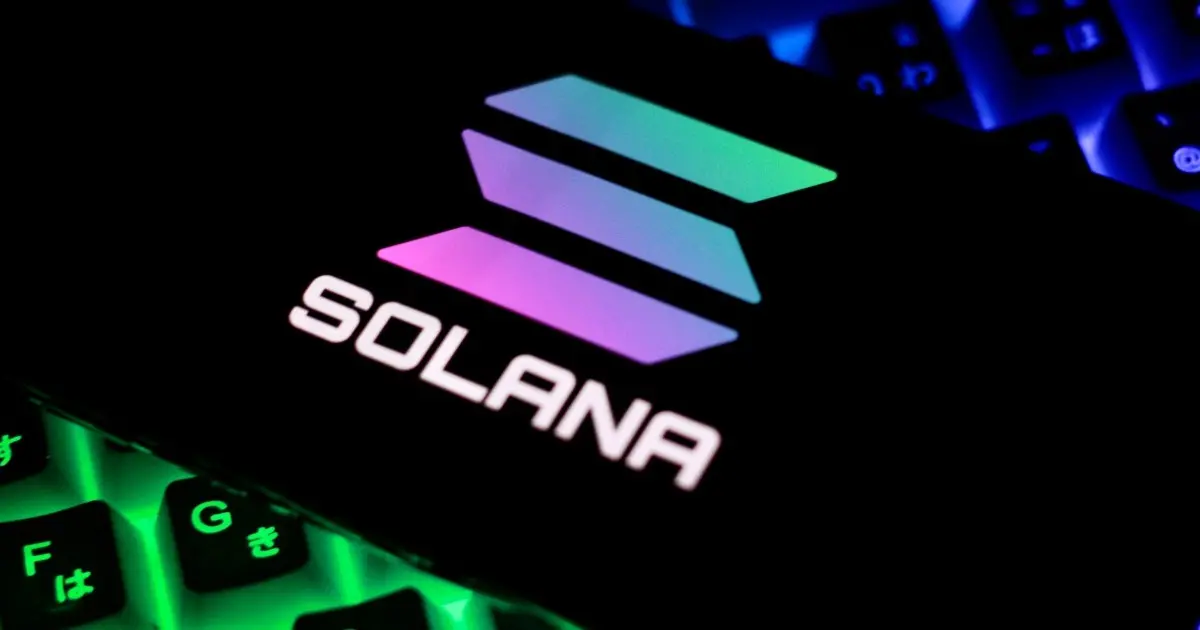Six months after the collapse of FTX, on-chain data is warming up. Is Solana ready to "regain its glory"?
Author: Blocklike
"Some signs indicate that Solana may have the potential to regain its former glory."
More than six months after the collapse of FTX, news has emerged about the FTX 2.0 restart plan, which may have attracted the interest of major companies including Nasdaq, Ripple, and BlackRock. As some failed crypto companies (such as 3AC and the founder of PayPal Finance) re-enter the market with new products, discussions about whether FTX can make a comeback are growing louder.
At the same time, Solana, an important member of the FTX "family," has recently received widespread attention.
On one hand, Solana's co-founders have been very active in expressing their views on Solana, sparking community discussions. Whether it's becoming the Apple of the crypto space, not fearing pressure from emerging blockchain networks like Scroll, Base, and Linea, or believing that Ethereum could serve as Solana's L2 solution, these ideas reflect Solana's ambition to reclaim its former glory.
On the other hand, hot events surrounding Solana continue to add to its momentum.
- In April, the decentralized IoT wireless network Helium migrated to Solana, causing SOL to rise from $20 to $25;
- In May, the popularity of BRC-20 and meme tokens kept gas fees high, leading many users to turn to Solana for transactions;
- In June, the SEC classified SOL and other tokens as unregistered securities, drawing attention from the market and many industry insiders, including Vitalik;
Additionally, according to relevant data, in May, the number of daily active addresses on Solana reached a peak of 490,000, nearly equivalent to the 500,000 daily active addresses when FTX officially filed for bankruptcy on November 11 last year.
Once highly anticipated by the market, the public chain Solana saw its price plummet, TVL significantly drop, and many FTX-related projects within its ecosystem suffer heavy losses after the collapse of its biggest supporter, FTX, leading to a dramatic decline in its reputation.
Returning to mainstream status is a task Solana is eager to accomplish. So, can Solana regain its former glory?
From "Much Attention" to "Dull and Unremarkable"
As a public chain deeply tied to FTX, Solana was thrust into the spotlight during the FTX incident.
On the eve of FTX's collapse, it was revealed that the Solana Foundation held a large amount of FTX-related tokens, including approximately $107 million worth of FTT and $83 million worth of SRM the day before FTX's assets were frozen. This asset exposure highlighted the close relationship between Solana and FTX, leading to a chorus of voices predicting Solana's decline.
On November 11, 2022, as FTX officially filed for bankruptcy, Solana suffered significant damage to its reputation and ecosystem.
The platform token SOL plummeted from $36.72 to the teens, and by the end of December 2022, SOL even fell below $10, with the market share evaporating by tens of billions of dollars in just over a month.
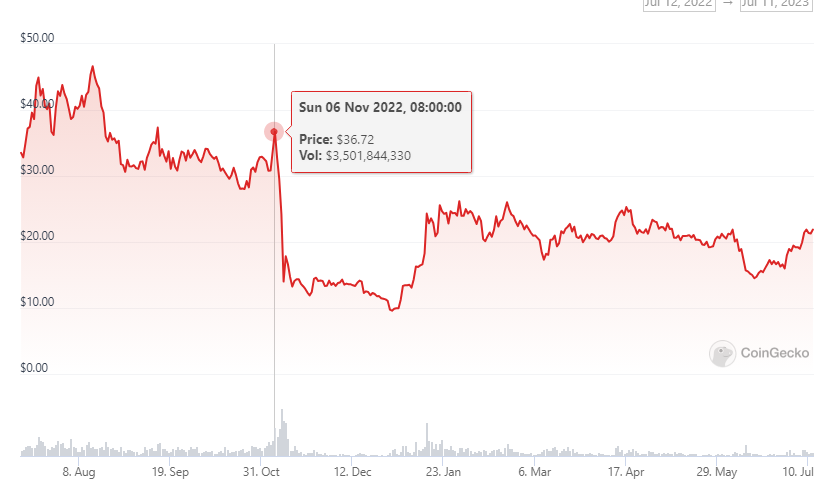
Serum, as the first DEX on Solana, occupied half of the DeFi liquidity on Solana, but its trading volume and liquidity dropped to zero due to the impact of FTX. Other FTX-related platforms and non-FTX platforms either faced liquidity crises or were forced to shut down due to a lack of funds.
Before the FTX collapse, Solana's ecosystem had nearly $1 billion in TVL, which fell below $300 million and has yet to exceed that amount.
"Ethereum Killer," "Next-Generation Blockchain," "High-Speed Public Chain," "King of DeFi"—these were all titles the market bestowed upon Solana, reflecting recognition of Solana's technology and ecosystem, as well as expectations for the rise of new public chains. Before the FTX incident, Solana was already facing a public relations crisis due to frequent outages and large-scale asset thefts, and FTX's collapse directly brought Solana to its lowest point.
The once-popular new public chain seems to no longer be the "darling" of major media and capital, and the landscape for new L1 public chains has changed, forcing Solana to fade from the historical stage for a period.
Is Solana "Dead"?
Some voices believe that Solana has lost its competitive position among L1 public chains. Without the attention from a large number of external sources and its past glory, Solana now seems to be struggling.
However, there are also many voices suggesting that the most direct impact of FTX's collapse on Solana was the price of SOL, which has instead allowed Solana to "shake off financial speculators" and return to genuine technological development.
Is Solana really "dead"?
SOL Price Rebounds, On-Chain New Address Count Surges
According to CMC data on July 10, the price of SOL was $21.2, ranking ninth in market capitalization. This price has rebounded significantly compared to the $9 during the FTX crisis, with an increase of over 130%.
According to The Block data, the number of daily active addresses on Solana saw an increase again in May. On May 17, the number of active addresses on Solana reached 493.1K, up nearly 55% compared to the lowest daily active address count in the first half of the year.
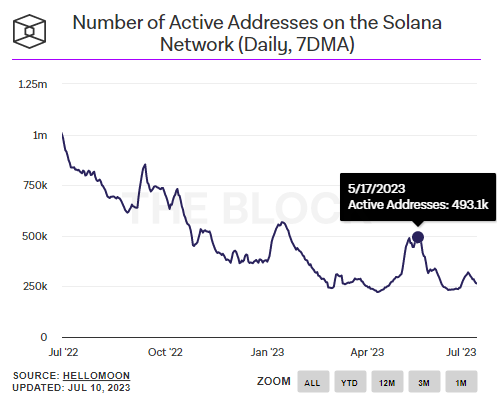
Notably, the number of new addresses on the Solana chain also saw a significant surge in May, with an increase of over 300,000 addresses at its peak.
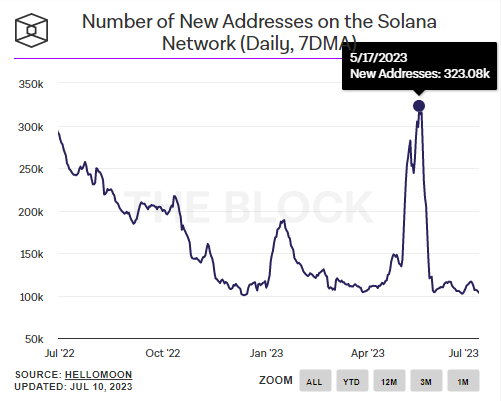
Some analyses suggest that the surge in addresses on Solana in May is related to the rise of meme coins and BRC-20. The popularity of meme coins and BRC-20 has kept gas fees on the Bitcoin and Ethereum networks high, prompting many users to turn to Solana for transactions due to its lower gas fees and faster speeds.
Developer Count Remains High
For a public chain, the number of developers is one of the important indicators of its popularity and a crucial component in driving ecosystem development. The good characteristics of the Rust language and Solana's high performance remain attractive to developers.
Although some developers chose to "escape" after the FTX crisis, the overall number of active developers on the chain remains relatively stable and maintains a leading position.
According to the latest data from developerreport.com, the number of monthly active developers on Solana ranked fourth on June 1, reaching 363, which still shows a certain advantage compared to other public chains. Additionally, the most followed repositories on GitHub for Solana have 455 contributors, while the most followed repositories for Polkadot, Polygon, and Avalanche have 261, 51, and 82 contributors, respectively.
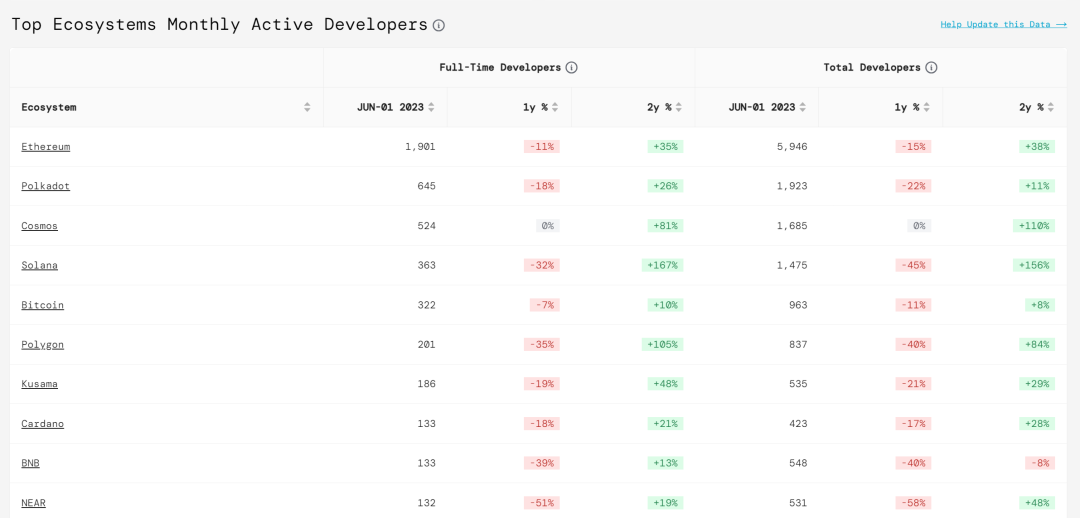
Source: developerreport.com
Liquid Staking Performs Well
With the popularity of liquid staking, the Solana ecosystem has also seen a surge in liquid staking, bringing Solana back into the mainstream market's view recently. According to StakingRewards data on July 10, SOL is currently the second-largest staking asset, with a staking market value exceeding $8.3 billion and a staking rate of 69.64%.
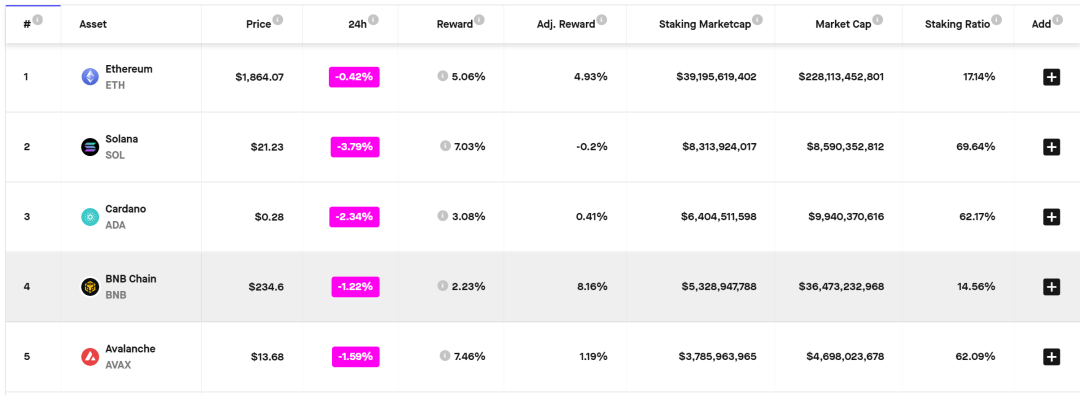
NFT Sales Enter Top 3
According to Cryptoslam data, in the past 30 days, Solana's NFT sales ranked third, only behind Ethereum and Bitcoin NFTs, surpassing Polygon's NFT sales by about $40 million in the past 30 days.
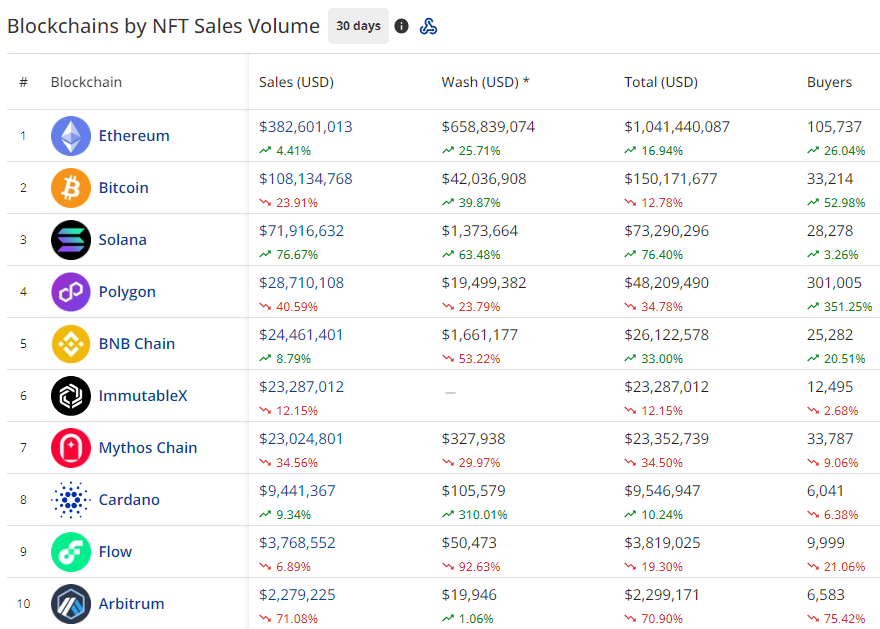
Some Opportunities and Challenges
Currently, both L1 and L2 face intense competition, and Solana is also "rushing" to attract users and developers:
- In early April, Solana announced a new method for storing data called "state compression," significantly reducing storage costs. According to the official introduction, this method can be used to store any type of data on-chain, with the first application being the compression of NFTs. Users can mint 1 million NFTs for about $110.
- On April 13, the Solana phone Saga was launched, attempting to attract more crypto users through a Web3-centric Android smartphone.
- Continuously hosting Solana Hacker House events in multiple cities to embrace more developers from around the world and enhance the value of the Solana chain itself. In May, the Solana Hacker House landed in Taipei, and in November, this event will also go to Hong Kong.
- Launching the "NFT Showdown" competition to promote the development of the NFT ecosystem.
- Introducing a $10 million grant program for AI-focused projects based on Solana.
Moreover, the community's optimistic voices about Solana seem to be increasing. KOL @CryptoKaleo, who has nearly 600,000 followers on Twitter, recently expressed his views on Solana, believing that Solana's continuous building after the FTX collapse may allow it to return to its pre-bankruptcy level in the upcoming development. This viewpoint has also garnered support from some users.
These are the opportunities for Solana, but it still faces challenges.
In the face of the rapid expansion of other public chains, Solana still needs to take more measures to expand its ecosystem. Additionally, the trust crisis caused by the FTX collapse still exists, and strengthening ties with the community and enhancing community confidence are also key areas that Solana needs to focus on.
Can Ambitions Be Realized?
Recently, Solana co-founder Raj Gokal stated that Solana has the potential to become the Apple of the crypto space, aiming for 10 to 100 times growth through partnerships with small businesses and infrastructure.
Raj believes that the launch of the iPhone took Apple nearly a decade of research, and the Apple app ecosystem reached its current level, all starting from "an unwavering focus on simple interactions that must work perfectly," which is also the focus of Solana's core engineering and ecosystem. This analogy seems to suggest that Solana's silence is actually a period of accumulation, with a sense of "quietly preparing for a big move."
Additionally, with the launch of new products by Three Arrows Capital and the founder of PayPal Finance, the concept of "bankruptcy restart" is gaining widespread attention in the crypto community. If FTX 2.0 restarts, it will undoubtedly regain interest from users and institutions, and FTX-related projects led by Solana may have the opportunity to reclaim their former glory.







